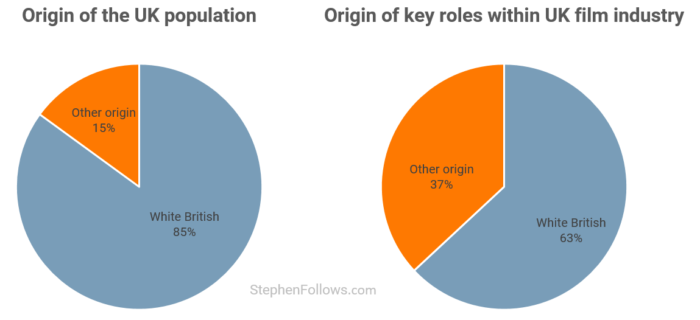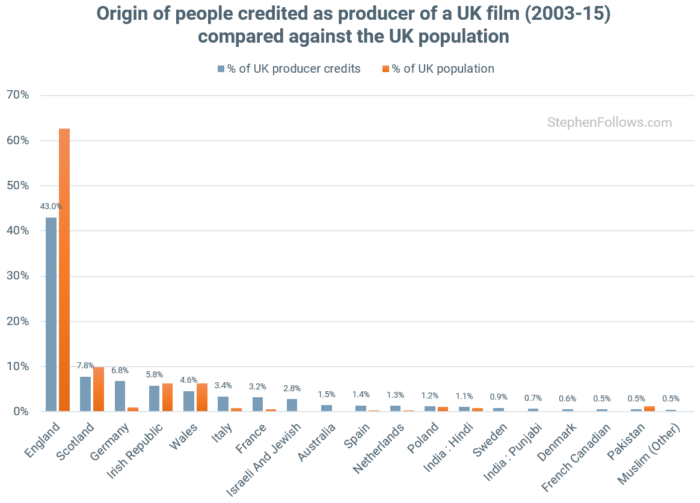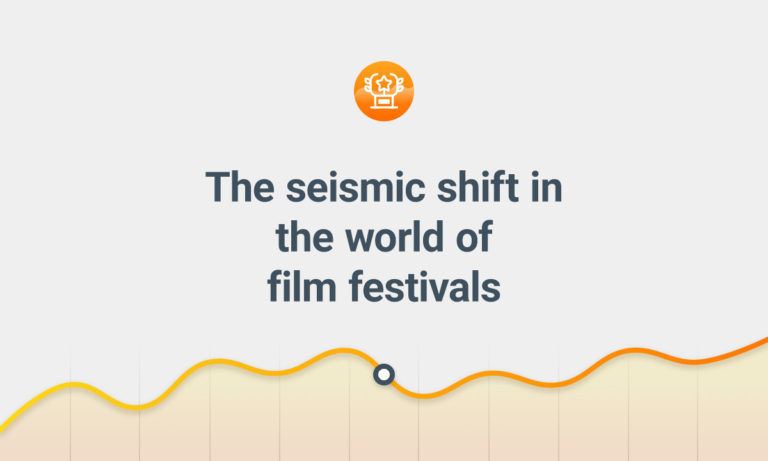 In the past, I have conducted quite a bit of research into gender inequality in the UK film industry. I often receive questions asking when I’m going to tackle race to the same degree I have researched gender.
In the past, I have conducted quite a bit of research into gender inequality in the UK film industry. I often receive questions asking when I’m going to tackle race to the same degree I have researched gender.
My answer has always been two-fold: yes, I’d absolutely love to but sadly I don’t have a way to perform the classification. Race is a more complex issue than gender and is hard to measure from the outside. And because of this, race has gone largely ignored while gender gets ever better analysis and research.
However, I think I have now found a reliable method and am ready to start addressing questions around race in UK film. That’s the good news. The bad news is that it’s going to take more resources than my gender studies. Most of my gender research has been for this blog so didn’t need any outside funding or support and the biggest piece I performed on gender (the 150-page Cut Out of the Picture report) was supported by Directors UK.
In order to perform the same analysis on race in UK film, I’m going to need more support. Before I expand on that, let me first tell you a little more about my new method and give you some findings we’ve already uncovered.
The Webber-Phillips model for measuring ethnic origin
The new method comes courtesy of Professor Richard Webber and Trevor Phillips.
and Trevor Phillips.
- Professor Richard Webber is the originator of the postcode classification systems Acorn and Mosaic and is a former Director of Experian. He is a visiting professor at Newcastle University and a fellow of the Market Research Society and the Institute of Direct Marketing.
- Trevor Phillips OBE is a writer and broadcaster. He is the former Chair of the Equality and Human Rights Commission, the Commission for Racial Equality and the London Assembly. He is currently the President of the Partnership Council of the John Lewis Partnership, and the Deputy Chair of the Board of the National Equality Standard.
Together, they have built up the Webber-Phillips system which uses name data to classify people according to the part of the world that their forebears are most likely to have originated from. Each person is placed into one of 200 different ‘Origin’ types on the basis of their personal and family names.
The raw data comes from two datasets; one containing the personal and family names of 527 million adults from around the world and another with personal and family name frequencies covering another 529 million adults. In total, they have data on over a billion people across 18 countries. They have used this to build up origin data on over four million family names from the UK. They describe their system like this:
Using a file of some four million family names and some 800,000 personal names built up during a ten year research programme, it has proved possible to associate each of the 130,000 names on the [UK film] database with one of some two hundred different “Origin” categories, each of which represents a distinguishable ethnic, linguistic or religious grouping. Thus Hindu Indians, Sikhs, Tamils and Pakistani Muslims are each recognisable as a cultural group and each has a portfolio of names which distinguish its members from each other and of course from native Britons.
Applying their origins research to study race in the UK film industry
I have been working with Trevor and Richard to apply their system to my database of the UK film industry.
My database tracks 3,400 films made in the UK since 2003, and includes over 497,043 crew credits and 101,219 cast credits. Together, we’re able to get a sense of the ethnic diversity of the UK film industry. A preliminary look has revealed that the Webber-Phillips system can reliably ascertain the origin of over 95% of people who have worked on a British film in the past thirteen years.
So what have we found?
We started with a list of every writer, director, producer and cast member of a British film made between 2003 and 2015.
Across all of these names, we found that the film industry as a whole is much more diverse than the UK population. 85% of the UK population is classified as “White British”, compared with 63% of people in key film roles (i.e. writers, producers, directors and actors).

However, this diversity is far from uniform. As Professor Richard Webber puts it:
The roles these different groups fulfil are very different. If a person had a black Caribbean name or one typical of American Blacks, then there was hardly any chance at all that that person would be anything other than a member of the cast.
By contrast the role of producer is particularly associated with people with Jewish or Armenian names. For example 40% of the Jewish names on the database were producers but fewer than 5% of the Nigerian names.
It seems that there are certain cultures which foster creativity as a writer and that these are issues relating to culture rather than integration or prosperity. For example, people whose names are associated with any of the South Asian groups are particularly likely to be writers.
A look at the origin of producers of UK films
To illustrate the level of detail that’s possible, we looked specifically at the role of producer. We studied the origin of all producers’ credits on British films shot between 2003 and 2015. This amounted to 21,465 credits, shared between 11,812 different people (i.e. each producer received an average of 1.8 credits). All ‘flavours’ of producer are included, including producer, executive producer, co-producer, associate producer and others.
The chart below shows the percentage of UK producer credits for people of the listed origin, compared against the general UK population. I have only included origins with at least 100 producer credits.

Origins which appear to be disproportionately under-represented (compared to UK population) are:
- Pakistan
- White British (i.e. England, Wales, Scotland and the Irish Republic)
- Poland
- India : Hindi
- Muslim (Other)
Origins which are more frequently found among UK producing credits than in the UK population as a whole are:
- Australia
- Israeli And Jewish
- Sweden
- French Canadian
- Germany
What’s next?
There is so much more work to be done on this topic. Even looking just at the producer credits, we need to further investigate the people involved (not just the credits), subdivide by type of producer credit, scale of film and many other factors. In my recent gender report, we found that these sub-divisions were essential to understanding how the industry is operating. For example, as budgets increase, fewer women are given the chance to direct (16% of films under £150k are directed by women, whereas just 3% of films budgeted over £30m).
And we would like to look at much more than just producers. By using Trevor and Richard’s system, in collaboration with my database of UK films, we’ll be able to measure every job role within the industry.
So why don’t we? Well, the research above has been achieved without any kind of funding or support but in order to be able to study the industry as we feel is necessary, we’re going to need the backing of some people and organisations.
So, if you feel you or your organisation can contribute, then please get in touch.
At this stage, I don’t know if we are going to find one body who can support us or if we need to build a coalition of people and bodies. And, quite frankly, I don’t mind. I am only focused on being able to do this research and shine a light on race within the UK film industry
Epilogue
It’s worth asking ourselves why the ethnic origin of film industry personnel matters. For me, it comes down to three reasons:
- Who are we? We as an industry should be able to get a clear picture of who we are and then we can all pitch in our thoughts as to whether we are satisfied with our current practices. Within my gender research, we discovered a stark difference between perception and reality, in that most industry professionals had no idea just how pro-male / anti-female the industry’s processes were.
- Identify unfair practices. By studying cast and crew we are able to identify unfair and discriminatory practices within the way the industry functions. It’s my opinion that we don’t need to be working towards some kind of Platonic ‘perfect mix’, but rather that everyone entering the industry should have equality of access.
- Films matter. Culture can be defined as the stories we tell ourselves about ourselves. Therefore, if part of the ‘British culture’ is reflected through UK cinema then we need to ensure we have diverse creatives telling their stories.
Outside of this epilogue, I have avoided making value judgements on today’s findings for a couple of reasons. Firstly, my opinion is the least important part of this project. My main interest is in measuring and explaining, rather than decrying or campaigning.
Secondly, we are a long way away from having enough data to start talking about ‘problems’ or ‘solutions’. We need a much clearer picture of what’s really going on before we start to look at what should change. For example, there are a number of factors that could explain today’s findings. These include the concentration of film workers in London (which is far more diverse than the UK generally), the choices made by people of different backgrounds (children of first generation immigrants could find that family pressures make it harder for them to pursue a career in the arts) or any number of other factors.
On a final note, I would remind everyone that we need a mature, adult debate about this topic. Our focus should be on methodology first, then data and analysis and then finally debate on what should or shouldn’t happen. It’s easy to spin most of these data points to seemingly validate one opinion or another. For example, it’s both true that 40% of the people with names of Jewish origin (within writers, producers, directors and actors) are producers, but it’s also true that only 2.8% of producers have names of Jewish origin. One sounds high and one sounds low. Both are true and either could be used to further an already-formed entrenched opinion.
The wider truth here is that we need to build up a detailed, data-driven picture of our industry and then use to it identify any unfair and discriminatory practices. It’s certainly possible that we conduct the full research and end up proving that the UK film industry is equally open to everyone of all ethnic origins. However, I suspect that we will find areas that need improvement. We as an industry should be introspective, aware of how we operate and consciously striving to make it more meritocratic for all.
If you can help fund this, then drop me a line.
Notes
Race can be a very contentious topic, and even the definition is open to interpretation. Therefore, just to be really clear what we’re measuring here, I asked Professor Richard Webber to explain in a little more detail. He said:
The classification is based on names and although races tend to have their own distinctive names sometimes religions do as well. So we can’t really call Sikhs a race but we do know from using origins that behaviourally they are very different from Hindu Indians. Albanians may be an ethnic group but they don’t just come here from Albania. We often refer to origins as a system based on cultural, linguistic and ethnic factors. Describing it as a system which classifies people according to the culture of their forebears often works well.
The research is looking at all films shot in the UK. Much of the identifying of such films has been initially done by the BFI. They tracked all films budgeted over £500,000 shot between 2003 and 2007 and films of all budget ranges since 2008. I have then added missing films, removed erroneous records and expanded upon that initial list.
‘White British’ is a defined term and includes people who originate from England, Scotland, Wales and the Irish Republic.
The headline figures today relate to the credits, not individuals. That means that if someone worked on two films then this will count twice for their origin. In a fuller piece of research we can provide both this method of counting, as well as look at the origin of the individuals working in UK film.





Comments
Hi, This is an interesting approach. May I ask how the Webber-Phillips system handles the surnames of married women who take their husband’s name? Surely analysing that will not give an accurate estimation of origin for those women? Does the system account for this?
I also suspect that since surnames run across many generations, any ethnic origin implied by a surname may go back centuries and perhaps no longer be identified with by the holder of that name today.
Hi Louise,
Great question. Any system which judges people from the outside will never be 100% perfect, so we rely on data scientists such as Professor Richard Webber to safeguard the validity of this research. I asked him to explain a little on the topic of marriages and he said…
First it is important to bear in mind that what we are doing is to compare a distribution of people behaving in a particular way against a “base” distribution, in your case the country as a whole. You are not aiming to correctly code each individual on your file, you are looking to see whether some groups are over-represented compared with the UK population. If no women adopted the surname of their husband, then the distributions would not be materially different (unless women from some communities were more likely to take their husbands’ names that others). If inter-marriage were random then the distribution of your file would be very little affected and that of the UK base not at all. In fact, if say Jewish women were particularly likely to be directors and you were undercounting them because some adopted their husband’s surname, then the variations you have found would be even greater.
What we do know is that inter-marriage is most common among groups which are culturally not that different from the white British. By contrast, we know that South Asians are among the least likely to inter-marry. For example, fewer than 10% of Bangladeshis have first names that are white British. So, to the extent that inter-marriage is a problem, it is least likely to be a problem among those groups who are most culturally different and therefore who are least likely to be on your file. This is beneficial since it is the disadvantage of these groups we are mostly trying to record and address.
The fact that Origins is looking at people’s heritage is usually beneficial. A good example is to be found in Scotland where people with Irish surnames, mostly Catholic immigrants, refer to themselves in the 2011 census as Scots but behave like Irish Catholics. How do they behave differently? For a start they fill the 40,000 seat Parkhead Football Stadium where Celtic play. Celtic’s regular attendance is as great as the total number of people recorded as Irish in Scotland in 2011. They were also overwhelmingly more supportive of Scottish independence because of their historic dislike of Westminster. These difference, football support and voting, would not have been visible if one had left people to select their own identity on a questionnaire. That answer is more likely to be determined by how people would like to be treated and what they believe their legal entitlement is. Mostly self-completion gives a forward-looking categorisation, one which is more relevant perhaps in certain contexts, less so in others.
One interesting consideration is how researchers and the census assign social class. If you have people with two different occupations in a household, do they belong to different social classes? The answer is probably not. The census mostly allocates social class to people based on the occupation of the “head” of household. The situation is not dissimilar with Origins – though as with social class members of a household may differ as to who they think is its “head”.
If a producer doesnt have a ‘typically’ African or Caribbean name and is called say Charles Thompson and see themselves as Black British for classification purposes, how would that person be classified in your analysis of the orgin of people credited as producer… ?
Hi Charles
This was one of the first questions I had when I first met Richard and Trevor. On the face of it, it seems strange to be able to tell the origin of someone just from a name. But when you take a large enough dataset, and compare it to known ‘norms’ (like the census) you’re able to look for differences.
The origins method is not really about classifying each person and leaving it at that. It looks at the difference between datasets. So if we compare the number of Afro-Caribbean names associated with UK films with the number of names in the UK population then we can get a sense of under and over-representation.
In addition, Professor Richard Webber and his team have spent time to tweak their system to take account of quirks in the names of people in the UK and so will also ready have accounted for things like the nature of Afro-Caribbean names.
Hope that helps
Stephen
The correlation between last name and ethnic origins is flawed. Sorry… There is no science behind the idea that because you have a foreign name, you are foreign or an ethnic minority…. nor that you are perceived to be…
Just from my own anecdotal experience, I can tell you that I have NOT experienced that this industry is 37% non-white.
Did you really need to invent a method to try and classify more white people as “other” so you could justify terrible representation for non-whites working in a predominantly white industry.
Sadly, this is flawed at the core.
Hi Tina
Thanks for your comment.
Before I talk about the method I should note that the research didn’t conclude that the dataset we looked at was 37% “Non-white”. It was 37% non-White British, meaning that there are many origins which would be included in the classification of “white” which are included in that 37%, such as Americans, Europeans, Australians, etc. But I know that wasn’t your main point so I shall move on to the system itself.
I fully understand your scepticism, and I was once where you are now. But I have spent a lot of time looking into this and it does look like it is a very solid method for researching origins.
I’d start by saying that we’re not inventing anything. Far smarter and more knowledgeable people than me have developed this system and it’s been in active use for a while. The data come from absolutely huge datasets and so it’s not based on theories, but what’s really happening in the world. The system is tweaked using real-world data to accurately reflect the UK population and stacks up well against things like the UK census. The people behind it are world-leading experts in the study of such data and have made entire careers on this kind of research. They are open about their methods and datasets, meaning that if it were false or not scientifically defendable then it would have been struck down long ago.
This is why it’s already in wide use all over the world. Insurance companies, credit agencies, banks and other major institutions pay huge amounts of money to use this system, and others like it. They do this not out of a sense of dogma, but because they have seen it to be consistently reliable in analysing populations.
I’d note that the dataset we looked at for this research above includes actors as well as writers, producers and directors. There are far more actors than the other roles, meaning that the overall figure will be heavily skewed by actors. As Richard notes above, he has already seen that the acting population is more diverse than producers. In a full study, we will be able to pick apart these numbers and look at what’s really going on, including separating lead actors from other cast members and extras. It would be my guess that we see something akin to what we found with female directors, whereby the bigger the film and the more important the role, the less diversity we see.
Finally, another thing I found when looking at gender was that no one person had a good sense of the industry as a whole. That’s because everyone only has their own personal journey and the anecdotes they’ve heard along the way. The industry is a vast, sprawling world of many third parties and each corner operates slightly differently. Almost everyone we met had a strong opinion about the industry’s relationship with gender but it wasn’t until we looked at the numbers we could make sense of it all. We met a few people who felt that there was no problem with gender equality in film as they had happened to work with three female directors in a row. From their honest opinion, female directors were plentiful. That’s not to say that their or your experiences are not valid, but just that we need to study the numbers behind the industry to see the big picture.
In an ideal world, I would love to have an all-seeing eye which could impartially and perfectly deduce the race of all film professionals but sadly that’s not possible. So we have to work with what is possible. It’s my personal opinion that the lack of methods to track race has played a big part in keeping diversity back, and so we should grab every method we can to study the topic.
I hope that has answered some of your concerns.
Stephen
Whose systems. For whom. Invented by whom? Serving whom? Debated with whom? Accepted by whom? For whom does this empower?
What does this research serve? It’s even on the most basic level patently flawed.
Sorry but totally do not see eye-to-eye on this but as you know, I am a HUGE fan of your work.
No problem – let’s agree to disagree 🙂
I promise to keep being open about the methodology and what the results actually relate to. I also promise to keep discussing the research, it’s findings and the topics more generally. Please keep reading the research and adding your thoughts. I hope to bring you round with data and evidence but what I want above all else is a healthy debate.
I’m happy to debate all aspects of the systems, methods and processes for my research because (a) I want it to be accurate and the best way is to be open to criticism and (b) in these debates we get to talk about issues which really matter. Race is too often ignored in UK film because it’s a complicated issue which many people have strong feelings about (ranging from anger to awkwardnesses). So I think it’s important to study it and for anyone with an intelligent point of view to chip in.
Quick response (above) before I leave for work… I will have more thoughts to come back with you with.
Other than Trevor, who else of this “ethnic other” was consulted before completing this data?
And thanks very much for endeavouring to do this work.
I have met with a number of people and organisations about studying race in the UK industry. I don’t want to reel off a list of names as (a) some of those conversations are private and (b) it doesn’t really matter as I don’t want to be using people as cover. What’s most crucial here is to be open about the methods and what we’re measuring.
And thanks for your thanks 🙂
“They do this not out of a sense of dogma, but because they have seen it to be consistently reliable in analysing populations.”
Who is this they? Are they non-white owned institutions?
Sorry but going to blow a lot of holes in this and I haven’t even begun looking at this in detail…
I will also add: that if there was indeed, as this study seems to suggest, 37% representation of “non-white identifying individuals” working in the film industry, then many of us might say… well, no problem here. The statistics from many other studies do not line up with this.
So, again, I must ask who determined the method of measurement and who you consulted with. I don’t see how those can be ‘private’ conversations if you talk about wanting transparency. Knowing the methodology and rational for a study and how key stakeholders, who may be represented in the study or indeed have interest in the results of a study, were consulted does matter.
If you want me to buy into this, I need to know how the decision to use this method of analysis was reached. You say you were convinced that this was a good way of measuring RACE (after all, this is what the study purports) but I am concerned that this study is already flawed in definitions it sets out. Saying that insurance companies and others use these as parameters doesnt really mean anything to me. I have no faith that these are organisations whose interests are racial equality or fairness. Their agenda is not an agenda that strives for diversity and representation… so clearly irrelevant. Their measure and a measure that might see beyond simple ‘names and origins’ might be necessary here. And if you really do want engagement, here it is.
And other people are reading this, BTW, and not able to comment because you are not able to do so anonymously on your blog (I have already heard this from someone). So if you want engagement, you will have to realise some people will see that if they represent their views, it may impact their employment opportunities.
Consultation seems extremely important at this state before continuing. However, if you have done this consultation, then apologies. Also, Trevor Philips is one individual and he does not represent the entire diverse communities this refers to (and neither do I, of course!).
Again, this is very important and I am so please someone is taking this on… however, the assumption on how race, difference or dominant groups are defined is seriously in need of discussion.
Over and out.
Hi Tina
I’m really not trying to nitpick but it is worth me pointing out again that this did not say that 37% of the industry is non-white. The article shows that from the list of writers, producer, directors and actors, 37% have an origin other than ‘White British’. As I put in the epilogue, this topic needs so much more study. For example, a high number of non-‘White British’ extras would skew the figures, even if every single senior employee and creative was ‘White British’. Secondly, I mentioned the UK average for scale, but I also pointed out that a lot of film work is carried out in London (67% of film jobs are in London and the South East https://stephenfollows.com/how-much-of-uk-film-industry-is-london-based). I don’t have the London average but I think it’s a fair guess that London is far more diverse than the UK at large. These are all distinctions for which we need a proper study.
We may have to agree to disagree on the validity of this research method as I don’t share your view that the fact insurance companies, banks et al use it is irrelevant. I completely agree that it seem unlikely they’re using it to promote inclusion or for any positive social aim, but I do believe that it is in their commercial best interest to have the detailed picture of the UK population as possible. It allows them to price products, target advertising and make strategic decisions. Again, I don’t think they do that with our best interests at heart! But I do think they have worked to develop tools which accurately show what types of people are included in whatever dataset they’re looking at. And that’s why I feel their use of this type of system is a useful point of validation (but I can appreciate why you disagree).
You’re right that origins and race are not synonymous, and I hope the article makes that clear. (If not, I’m happy to amend it to make it clearer). But it’s the closest proxy I am yet to find, which allows me to study the whole of the industry over time. If there are any better methods then I am extremely open to hearing about them.
But in the absence of any other methods, I’m keen to pursue this system as it should at least give us some clues to if and how the industry is discriminatory. In my work in gender, this detail was vital in signalling to us that the industry is discriminating against women. If we had used the headline figure (14% of directors are female) then we would not have been able to prove just how pervasive the unconscious bias was. It was the subdivision of the data which revealed the truth – and that’s what I’m hoping to get to with a wider study using this origins method.
The alternative of continuing to leave this topic unstudied seems far worse to me, than the fact this system is not perfect. To mitigate any problems with this method I intend to…
1. Be open about the methods used. The explanations of origins and how they differ from notions of race should be in all of the work.
2. Clearly communicate what our findings actually show. I can’t control how people interpret the findings, but in all articles and reports I write, I hope it’s clear what we’re talking about.
3. Ensure that my opinions are clearly labelled as such. The data and what I think about it are two very different things. My principle aim is to give everyone a better picture of the makeup of our industry. I would like to do this by every measure we can (gender, race, disability, sexual orientation , age, etc).
4. Be open to thoughts and input from everyone. Just as this debate we’re having will inform other readers, I want our findings to be clear and open to disagreement. There is unlikely to ever be just one way of reading the data and everyone should be empowered to draw their own conclusions.
On you note about my comments section, I think it’s fair to ask people to put their name to the comments, as I do in all the articles and comments I write. I find it encourages intelligent debate (as you and I are having) and is no barrier to me receiving alternative viewpoints. The vast majority of times I solicit comments I also say that people can contact me via my contact form, and many people do. I have already received emails and contact form notes from people who wanted to privately let me know something, or ask a private question. I don’t remove comments (other than the insulting, the unintelligible or spam) and I actively encourage debate. It’s my personal opinion that allowing anonymous comments will lead to a lower level of debate (I speak from experience!).
Thanks Stephen for your replies, they are so well considered and address things fully. This is great debate and dialogue and I can really value that.
As I said, the research topic at the heart of this is really important and I am so appreciative of you doing this. Yet, I do think the debate about methodology needs to be addressed. I will put more thought into this and get back to you– I am not a statistical expert by any means.
There are people who I know would really want to get engaged (I am only one of them) and I would encourage you to get them to speak with you about their thoughts. I do not feel they will do this in your comment section as I have. I will encourage for them to get in touch.
Peace.
Wonderful 🙂
Take all the time you need to add thoughts. The comments in this (and every) article will remain open and it will be a topic I want to keep researching, using all the methods I can.
Yes, please encourage anyone with a viewpoint to get involved. They can do so publicly via the comments or privately via my contact form or by replying to my weekly mailouts. Plus, with a proper study, we’ll be able to actively seek out people to interview and collect thoughts from all corners of the industry. For the gender study we interviewed 174 people and their views were invaluable in shaping our opinion of what was happening.
Thank you for helping to improve this debate and please continue to be involved.
I do still find it ironic that by the system they “invented”, Trevor himself would * not * be classified as ‘black’ or non-white.
That was my first question to Trevor and Richard too 🙂
But it turns out that that’s not the case. The system has been tuned to the UK population and so Richard and his team have got good at accounting for how people of each part of the world name their children. For example, a lot of people coming from Jamacia have more “traditionally English” sounding names than those from, say, Nigeria. They know this and can account for it to keep their system measuring reality.
Also, the system could be wrong about one person or another, but the point is there is a huge amount of data and any such errors get lost in the margin of error. When you zoom out and look at a large group of people it’s extremely accurate.
On reading this it appears that you are actually concentrating on people on screen, and those in managerial or financial roles. I work on films and t.v. shows in the north of england and hand on heart can honestly say i,ve never seen anyone of colour working as a member of the film crew, i.e. sparks, fx,etc on these shoots. as this is the case then maybe you are not looking at the industry as close as you should be
You’re right that much more research is needed, including breaking down the data by the role As I say in the article, this isn’t really the research – it’s a call for support to do the research. We need resources and support to do it properly, and just a proof of concept we looked at key roles and cast.
Interesting stuff. I am surprised the dearth of research for race in the UK film industry, so even though I echo the reservations on the method used, I still have to appreciate the work you’ve done in putting this together. Hopefully you (or others) will be able to fine-tune and come up with better methods.
Thanks for the support. I totally get your point of view. I really wish there was a better option (and if anyone has one I can do please let me know) but in the absence of anything else, I refuse to do nothing on a largely ignored issue.
Congratulations on this fascinating study, and finding a way to look at this. I have been thinking about this too.
My input, how important are family connections to those entering the industry and which perpetuate the same kinds of people entering the industry as those who are already in it?
How long is the average project and what impact does the fact that most people are freelance/ self employed have in terms of an absence compared to a situation where people are employed and have legal rights around protected characteristics?
What impact do unpaid long term internships have on the make up of those entering the industry?
How can you carry out a study on race and representation, and yet have no representation of the various Black ethnic origins included in your graph? Am I missing something?
Hi Nadine
Great question.
The short answer is that we’re limited by the Webber-Phillips model. We can’t infer any additional data or classifications outside of what they have built the model to identify.
The slightly longer answer is likely to be related to the nature of classification. The larger and broader your categories, the better you can get reliable data but the more you include in some-what different things together under the same banner. Conversely, with too many subdivisions, the greater the chance of inaccuracies and the weaker the overall stats. (I.e. Everybody is a unique person and as soon as we start classifying, we’re already being reductive to some degree).
So in all cases, it’s a balance. You go with as many levels of subdivision you can, while also protecting the reliability of the results. It’s usually guided by two factors – what’s possible and what’s useful. In this case, it’s fair to say that race/family origin is massively understudied in the film industry. This lack of data is causing and perpetuating manly negative effects, which are more acutely felt by some, but we all suffer from the lack of diversity (to a much lesser degree, of course).
So I am more willing to investigate an overly-broad system than to not study anything at all. We must work to get better systems which better reflect the diversity of the real world, but we have to start somewhere.
Stephen